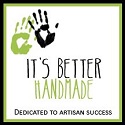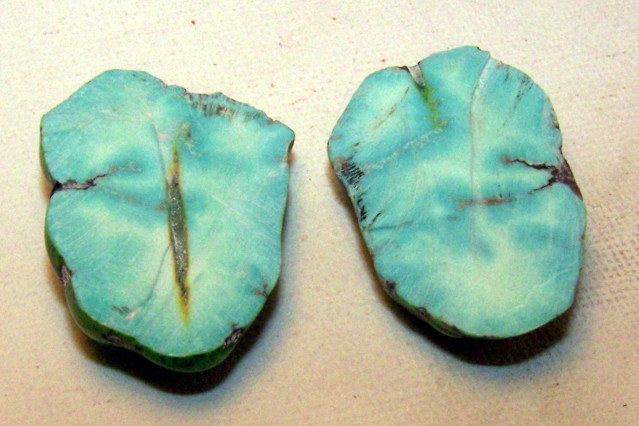Departments
Search
Follow Us
Tags
Latest Highlights
IBH
Buyer Beware vs. Full Disclosure
Debora likes to shop some of the big brick and mortar craft/art stores in our area. While at one, she purchased a large focal type bead that was identified as “turquoise.” Now after it has been sitting in her supply area for about a year or so; she asked me to cut it and make two cabochons for her. Oh well, I had barely started cutting when I knew by the color of the dust being spewed out that the stone was not turquoise. Below are two pictures of the stone, the first shows the two pieces after cutting from the outside.
Pretty green/blue and black. The second shows the inside of the stone.
If you look you can see the natural cracks in the white stone and where the dye that was applied to the stone has bloomed out from the crack. The actual stone is probably Howlite which has been dyed. Do try to be accurate when you are using gemstones/minerals in your art.
John
Posted by Rasmussen Gems and Jewelry LLC
Tags: fake handmade, fake turqouis, Full Disclosure, gemstone, Treatments
Posted in Information
16 Responses to “Buyer Beware vs. Full Disclosure”
Leave a Reply
You must be logged in to post a comment.




There are a lot of people who mislabel their stones by mistake, but, unfortunately, there are a lot who do so on purpose also. I have 2 books about stones that I take with me when I setup anywhere and that helps me a lot since I don’t know a lot of the stones.
First, thanks for sharing this. I have large beads that I had purchased from one of those stores too and they were labeled turquoise. I knew from the price and careful inspection of the label that they were indeed dyed Howlite. It was on the label, but in very tiny lettering on the back. Many people are not going to look at that. They are going to read the pretty large type on the front of the label and assume that it is what it says it is. I try very hard to make sure I correctly identify any material that I use and if I am not sure, then I say so. Sadly. many people do not do that and they are misleading their customers into believing they are getting something that they are not.
Great post John, thanks for the tip!
Awesome info John, I had old jewelry bought lots of years ago that my hubby bought as genuine turquoise and sterling. When I started to study stones and metals I realized some of my good stuff was fake!
Howlite is a great material and I do use it, I love the vivid colors they can produce but that is what it is and I feel like you it should be disclosed. Everyone who makes and sells jewelry should learn what they are selling, if you don’t know do like Teresa, say so.
Great job!
Great article John. Turquoise seems to be one of those that people like to fake people out with! Not too long ago I saw a very pretty necklace with some “pink turquoise” Well, yeah the person didn’t know there isn’t such a thing! Pink turquoise! really!
Don’t know much about stones of any type, but always interested in learning something new about whatever! Thanks so much for being so informative!
I never would have known. Glad someone knows the difference.
I am always careful to list the type of stones and whether it is dyed. Sometimes it is hard to know unless the stones are clearly marked when you order them. I have gotten picky about where I order my stones from based on the information they have listed. I have been doing some studying on my own also so when people ask I can give them accurate information.
Great article! Thanks for sharing…personally I think you can deduce from the price of a design or stone, whether it’s genuine or not.
I do have some real turquoise on hand, and it was expensive, but most of time I use dyed howlite, but am always honest about disclosing that to my buyers. I like to describe it as “poor mans turquoise”. Most of my customers are happy with that disclosure and they like the piece for what it is, not was it isn’t. – Lise
wow, that is just not right. I would probably buy, (and probably have already boughten) mislabeled stones, and would never know it. Thanks for the tip.
Debbi
–yankeeburrowcreations
For a long time I didn’t realize that magnesite was being used as a substitute for turquoise, and even howlite. There’s nothing wrong with using these dyed stone substitutes, but when selling they should be marked as such. If a stone seems to cheap to be real, it probably isn’t.
We should all educate ourselves and then pass on to others.
Debbie
[…] working with, whatever I am designing, it will be done for the love of creating. Visit my website http://www.lindafulghum.com to see examples of my work. Get some ideas for your special event or special someone in your life. […]
John, I am wondering, for the buyer without your eye for stones, how can one recognize a “fake” without cutting it open to avoid getting stung?
I’m not familiar at all with the different types of stones (except diamonds!!) and would probably never know.
first, know your dealer. reputable dealers will back their product. if it turns out to not be as described a reputable dealer should stand behind the product.
second, all jewelers are not gemologists, if in doube find a gemologist or appraiser to certify the stone. there are laboratories across the world that will do this (of course they charge for the service)
third, if the price does not fit the actual market price for the stone/piece, be wary.
John
[…] Go to Source Author: gemlover […]